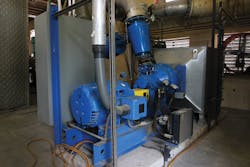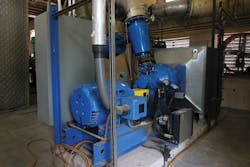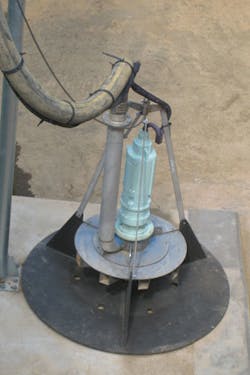Two Wastewater Projects Attain Energy Savings Using Different Approaches
By Paul Wood
Nationally, energy use at water and wastewater utilities accounts for approximately 35 percent of a U.S. municipality’s energy budget. Electricity use generally accounts for 25-40 percent of the operating budgets for wastewater utilities (NYSERDA, 2008). The wastewater community knows that there are often more energy-efficient ways to run their treatment plants. Energy efficiency is often not viewed as a reason to carve out a specific freestanding project. Time and again, energy efficiency is only included as an afterthought on major renovation projects. Sometimes, the original plant design has some inherent issue that must be corrected to enable more efficient strategies to be executed. Frequently, inertia prevents relatively easy changes from being made that could reduce energy consumption.
Recently, Lockwood, Andrews & Newnam Inc. (LAN), a planning, engineering and program management firm, completed two wastewater projects that resulted in significant energy savings. Though different approaches were undertaken at each facility, similar savings were obtained.
The first project, a renovation and renewal of the 10-million-gallon-per-day (MGD) Southwest Regional Waste Water Treatment Plant at the City of Conroe, Texas, involved implementing hydraulic modifications that allowed much better aeration control. This better aeration control was the key to ensuring that the newly implemented simultaneous nitrification/denitrification process would be successful.
The second project, the renovation and renewal of the 4.5-MGD Northwest Wastewater Treatment Plant at the City of Copperas Cove, Texas, involved replacing a multistage blower with a high-speed turbo blower, and replacing the diffused aeration system with a submersible aeration mixer while the aeration basins remained in service.
Conroe Wastewater Treatment Plant
In the Conroe project, the existing blower systems utilized five multistage blowers designed for use with the plant’s original course bubble aeration system. These multistage blowers were installed when the plant was built in the late 1980s. Two single-stage, high-speed blowers were installed in 2006 when the plant was converted to fine bubble aeration as part of an energy savings project.
Unfortunately, the hydraulics of the plant were not adequately investigated for this energy savings project, and the variation in the liquid depth of the basin, which occurred with varying flow, prevented these blowers from being fully utilized. The plant ran the fine bubble aeration system utilizing one or two of the existing multistage blowers instead of operating the single-stage, high-speed blowers, which routinely shut down due to discharge pressure issues. The plant therefore used its existing multistage blowers to provide air to the fine bubble system. This operating strategy allowed the plant to meet discharge limits but did not attain the full potential for energy savings benefits.
As part of a larger renewal and renovation effort, LAN designed changes to modify the basin configuration, moving the hydraulic control point from the clarifier weirs to new weirs at the aeration basin. This change has allowed the water level in the aeration basins to remain much more constant. The single-stage, high-speed blowers can now operate 100 percent of the time. Understanding the problems with and solutions to the blower issues allowed further modifications to the biological process.
The plant originally utilized the step-feed process, but the implementation lacked adequate control. Recycle and raw influent lines and valves were gravity fed from distribution boxes. The gravity lines and valves were oversized, no flow monitoring or controls were provided, so the operators had to “eyeball” flow into each zone.
The process was changed to an anaerobic/oxic (AO) configuration, and as part of the aeration system modifications, the full-floor diffuser coverage was modified into three zones with a tapered configuration. These aeration diffuser changes, in combination with the hydraulic changes that allowed the single-stage, high-speed blowers to be utilized, provided the means by which a greater range of air demands could be met. Control has improved to the point that simultaneous nitrification/denitrification has been achieved. Extremely low ammonia and nitrate values are obtained without any internal recycle. The denitrification, in combination with the low dissolved oxygen concentrations that allow very efficient oxygen transfer, has enabled the plant to achieve a 25-percent reduction in energy use compared with operations prior to the renovation and renewal project. The savings have averaged $10,000/month for the past 16 months.
“The modifications have enabled us to use our two existing high-speed blowers we had all but given up on,” said Greg Hall, Jr., wastewater treatment plant superintendent for the City of Conroe. “The new controls and modifications work really well and have made the plant easier to operate with the added bonus of greater control of the aeration system.”
Copperas Cove Wastewater Treatment Plant
The project at Copperas Cove involved a packaged plant that was originally designed to utilize coarse bubble aeration but had been modified when the plant installed fine bubble diffusers. The installed fine bubble diffusers were fairly unique and were not made by one of the established diffuser manufacturers. Unfortunately, these diffusers failed after a few years of operation.
For a number of years, the plant operated with the failed diffusers, which essentially acted as inferior course bubble aerators. LAN worked closely with the owner and operations staff, and ultimately recommended installing drop-in submersible aerator-mixers to allow the plant to remain on-line during construction. These aerators greatly improved the efficiency of the existing aeration process and allowed aeration basin mixing independent of the air flow rate for aeration. Additionally, the existing multistage blowers were replaced with high-speed turbo-blowers to provide a greatly increased range of air flow operation.
Copperas Cove has just recently completed the construction of these improvements, but initial indications are that this plant is also seeing energy reductions in the 25-percent range. Potential for greater savings with this aeration system exists. The design of this aerator allows mixing of the basin independent of air flow while solids always remain in suspension. With this equipment, air flow could be turned on and off while the mixer is still running. Using this strategy, on/off aeration could be implemented, allowing oxic periods for nitrification and anoxic periods for denitrification, thus allowing more complete utilization of the air supplied.
Conclusion
The examples from these different projects show that significant energy savings are achievable. There are still many wastewater plants across the country using course bubble diffusers that could make the change to fine bubble or other aeration systems with better transfer efficiencies.
For plants that have already made a change to an aeration system with high transfer efficiency, further improvements may still be possible if the biological process only implements nitrification and does not include denitrification. These two issues, course bubble diffusion and nitrification without denitrification, are low hanging fruits that are ripe for the picking. Further energy savings beyond these improvements are still possible, but will be incremental. One thing is certain, energy savings will not occur if areas of waste are not identified and changes to equipment or processes are not made to eliminate the waste.
About the Author: Paul Wood, P.E., is an engineer at Lockwood, Andrews & Newnam Inc. (LAN), a planning, engineering and program management firm. He can be reached at [email protected].


